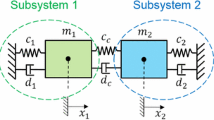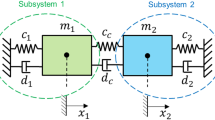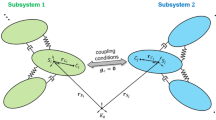Abstract
Co-simulation methods are used to couple two or more subsystem solvers in time domain. Considering mechanical systems, the subsystems can be coupled in two different ways, namely either by applied forces/torques (i.e., by physical force/torque laws) or by constraint forces/torques (i.e., by algebraic constraint equations). Here, we present and analyze a semi-implicit co-simulation method for the case that the subsystems are coupled by applied forces/torques. The semi-implicit approach (predictor/corrector approach) analyzed here is more stable than explicit coupling methods and numerically more efficient than full-implicit coupling schemes. Furthermore, the approach takes only into account partial derivatives of the state variables with respect to the coupling variables so that the Jacobian matrix, which is required for the corrector step, has very small dimensions. For that reason, this semi-implicit approach can be implemented very easily and very time-efficiently, especially for the case that commercial codes without full solver access have to be coupled. Within this paper, we focus on mechanical systems. However, the presented method may also be applied to couple arbitrary non-mechanical systems and arbitrary solvers.
Similar content being viewed by others
References
Busch, M.: Zur effizienten Kopplung von Simulationsprogrammen (On the efficient coupling of simulation codes). PhD Thesis, University of Kassel, Germany, Kassel University Press, (2012), ISBN-13: 978-3862192960
Busch M., Schweizer B.: Coupled simulation of multibody and finite element systems: an efficient and robust semi-implicit coupling approach. Arch. Appl. Mech. 82(6), 723–741 (2012)
Busch, M., Schweizer, B.: Numerical stability and accuracy of different co-simulation techniques: analytical investigations based on a 2-DOF test model. In: Proceedings of the 1st Joint International Conference on Multibody System Dynamics, Lappeenranta, (2010)
Carstens V., Kemme R., Schmitt S.: Coupled simulation of flow-structure interaction in turbomachinery. Aerosp. Sci. Technol. 7, 298–306 (2003)
Dörfel, M.R., Simeon, B.: Analysis and acceleration of a fluid-structure interaction coupling scheme. Numer. Math. Adv. Appl., 307–315 (2010)
Eberhard, P., Gaugele, T., Heisel, U., Storchak, M.: A discrete element material model used in a co-simulated charpy impact test and for heat transfer. In: Proceedings 1st International Conference on Process Machine Interactions, Hannover, 3–4 Sept 2008
Friedrich, M., Ulbrich, H.: A parallel co-simulation for mechatronic systems. In: Proceedings of the 1st Joint International Conference on Multibody System Dynamics, Lappeenranta (2010)
Gonzalez, F., Gonzalez, M., Cuadrado, J.: Weak coupling of multibody dynamics and block diagram simulation tools. In: Proceedings of IDETC/CIE 2009, San Diego, USA, Aug. 30 Sept. 2 (2009)
Gu B., Asada H.H.: Co-simulation of algebraically coupled dynamic subsystems without disclosure of proprietary subsystem models. J. Dyn. Syst. Meas. Control 126, 1–13 (2004). doi:10.1115/1.1648307
Haug E.J.: Computer-Aided Kinematics and Dynamics of Mechanical Systems. Allyn and Bacon, Boston (1989)
Helduser, S., Stuewing, M., Liebig, S., Dronka, S.: Development of electro-hydraulic actuators using linked simulation and hardware-in-the-loop technology. In: Burrows, C., Edge, K. (eds.) Power Transmission and Motion Control 2001, Professional Engineering Publishing, Bath, UK, pp. 49–56 (2001)
Hippmann, G., Arnold, M., Schittenhelm, M.: Efficient simulation of bush and roller chain drives. In: Goicolea, J., Cuadrado, J., Orden, J.G. (eds.) Proceedings of ECCOMAS Thematic Conference on Advances in Computational Multibody Dynamics, Madrid, pp. 1–18 (2005)
Kübler R., Schiehlen W.: Two methods of simulator coupling. Mathematical and Computer Modelling of Dynamical Systems 6, 93–113 (2000)
Lehnart, A., Fleissner, F., Eberhard, P.: Using SPH in a co-simulation approach to simulate sloshing in tank vehicles. In: Proceedings SPHERIC4, Nantes, France, 27.-29.5 (2009)
Meynen, S., Mayer, J., Schäfer, M.: Coupling algorithms for the numerical simulation of fluid-structure-interaction problems. ECCOMAS 2000: European Congress on Computational Methods in Applied Sciences and Engineering, Barcelona (2000)
Schäfer, M., Yigit, S., Heck, M.: Implicit partitioned fluid-structure interaction coupling. ASME, PVP2006-ICPVT11-93184, Vancouver, Canada (2006)
Schweizer, B., Lu, D.: Predictor/corrector co-simulation approaches for solver coupling with algebraic constraints. ZAMM- J. Appl. Math. Mech. (2014). doi:10.1002/zamm.201300191
Schweizer, B., Lu, D.: Co-simulation methods for solver coupling with algebraic constraints: semi-implicit coupling techniques. In: Proceedings of The 3rd Joint International Conference on Multibody System Dynamics and The 7th Asian Conference on Multibody Dynamics, IMSD 2014, ACMD 2014, Bexco, Busan, Korea, June 30–July 3 (2014)
Schweizer, B., Lu, D.: Stabilized index-2 co-simulation approach for solver coupling with algebraic constraints. Multibody Syst. Dyn. (2014). doi:10.1007/s11044-014-9422-y
Vaculin O., Krueger W.R., Valasek M.: Overview of coupling of multibody and control engineering tools. Veh. Syst. Dyn. 41, 415–429 (2004)
Woernle C.: Mehrkörpersysteme (Multibody systems). Springer, Berlin (2011)
Wuensche S., Clauß C., Schwarz P., Winkler F.: Electro-thermal circuit simulation using simulator coupling. IEEE Trans. Very Large Scale Integr. (VLSI) Syst. 5, 277–282 (1997)
Author information
Authors and Affiliations
Corresponding author
Rights and permissions
About this article
Cite this article
Schweizer, B., Lu, D. Semi-implicit co-simulation approach for solver coupling. Arch Appl Mech 84, 1739–1769 (2014). https://doi.org/10.1007/s00419-014-0883-5
Received:
Accepted:
Published:
Issue Date:
DOI: https://doi.org/10.1007/s00419-014-0883-5




